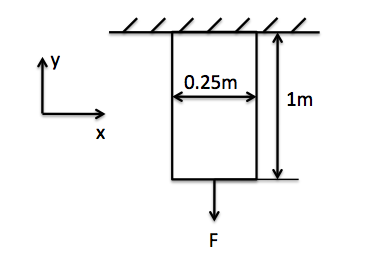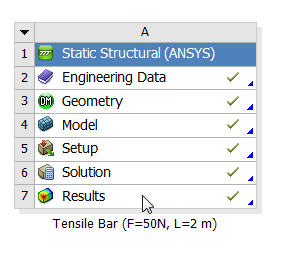| Include Page | ||||
|---|---|---|---|---|
|
| Include Page | ||||
|---|---|---|---|---|
|
Exercises
Learning goal: Critiquing computer results is an important engineering skill. To help you develop this "critical thinking" skill, this problem presents you with an ANSYS solution and asks you to critique it using hand calculations. We want you to tell us if the ANSYS solution provided in this problem has been set up correctly or if we are trying to bluff you.
Problem Statement: Go through the preceding Tensile Bar tutorial before attempting this exercise.
Step 8: Homework Exercise
A steel plate of width, w=0.25m, of length L=12m, and of specific weight ρ=density 7.9x10³kg/m³ is hung vertically from the ceiling. A force, F=10050N is applied as shown in the figure below. The thickness is 1mm.
The plate is so thin that there is no significant stress variation through the thickness. Assume τxy=0 at each point. Please determine if the FEM solution is correct. Justify your answer through quantitative reasoning.
See and rate the complete Learning Module Gravity effects are significant.
You can download our ANSYS FEA solution to this problem by clicking here. Unzip the file and load the project into ANSYS Workbench as in the tutorial. Double-click on Results in Workbench to bring up the FEA results that have been calculated already.
You should see the following results under Solution:
- Displacement
- sigma_y (i.e. σ_y)
- sigma_x (i.e. σ_x)
You might need to change the units for the results display by selecting Units > Metric (m, kg, N, s, V, A).
1. Look at the Displacement plot. From this plot, deduce if the model is constrained properly. Show your reasoning.
2. Does the sigma_y variation look right? Use hand calculations to justify your answer.
3. Does the sigma_x variation look right? Use hand calculations to justify your answer.
4. ANSYS solves a 2D boundary value problem (BVP). The hand calculation makes one or more additional assumptions to make this BVP tractable. What additional assumptions are made in the hand calculations? Where do these break down according to the ANSYS solution?
5. From the above 4 items, can you tell if the ANSYS model provided to you has probably been set up correctly or are we trying to bluff you? If there is an error in the set up, what might it be?
 Sign-up for free online course on ANSYS simulations!
Sign-up for free online course on ANSYS simulations!
